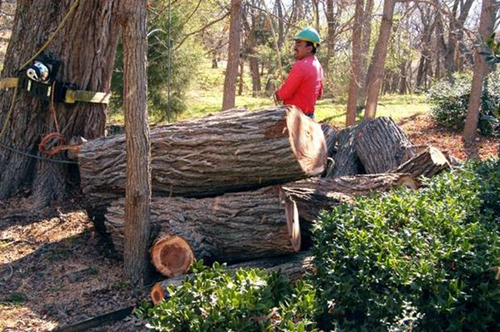How to Hire an Arborist

Neil Sperry, a McKinney resident, hosts Neil Sperry’s Texas Gardening from 8 a.m. to 10 a.m. Sundays on WBAP-AM (820). Learn more at neilsperry.com. Each week, Mr. Sperry will offer tips and instructions for making the most of your North Texas garden.

Published October 31, 2014, By NEIL SPERRY at Neighbors Go and NeilSperry.com
Invest in your shade trees by hiring professionals

Climbers from a professional tree firm inspect a huge pecan towering over the Sperry house. All Photos submitted by NEIL SPERRY.
A properly chosen and placed shade tree can be worth thousands of dollars in the resale value of a Texas home. Plus, all the while that it’s appreciating in worth, it’s also making your life much more enjoyable. It only stands to reason, then, that you’d protect that investment by hiring only highly qualified professionals to work on your trees.
How do you find a good firm? Based on my years in the horticultural industry, I’ll offer several suggestions. Start with a company that’s been in business for a long time. Get referrals from local nurserymen. Talk to your friends and neighbors. Ask for a list of five or six of their clients, and ask how their work has been performed. Above all, look for International Society of Arboriculture certified arborists. Those are the people who have studied the craft and proven their skills at a high professional level.
Most firms offer an option of annual or semi-annual visits by their representatives to check on the health and vigor of your prized shade trees. They will know the warning signals of trees in distress, and they’ll keep you apprised of any changes in your trees’ conditions.

A large American Elm was taken entirely to the ground, with each piece being lowered to one precise spot for removal.
Trees are mortal beings and, like all the rest of the animals and plants on our planet, they have life expectancies. As trees begin to mature, the arborist may point out branches that are starting to weaken. He or she may suggest selective pruning to remove weakened branches that could fall and cause harm.
Arborists also watch root flares to be sure a tree hasn’t been planted too deeply. That can lead to long-term stress and eventual tree loss. They’ll be on the lookout for roots that might be growing atop one another or pressing into the trunk. They’ll know what to do if you have roots that are starting to expand out of the soil to the danger of sidewalks, driveways or even the foundation itself.
If large branches overhang your house, consider having your tree-service specialist cable branches to support one another. It’s a skilled science involving tree-climbing, plant physiology and physics, and that’s yet another reason to be sure you have someone who is certified.
When the time comes to take a tree down or to remove a large limb, you’ll want a firm that has the equipment and know-how. I hired a firm to remove a huge native American elm in our landscape a few years ago. That tree was 48 inches in diameter, and I knew it was hollow. Outer branches were dying back, and it was only a matter of time until it might fall, taking out much of our backyard in the process. Almost as a challenge to themselves, they drew an X on the ground beside the huge trunk and promised me that every piece of that tree would be lowered to that exact spot. I watched for six hours as they did exactly what they had said. A 60-foot tree dropped onto one spot the size of a card table.
When it comes to tree service, don’t yield to door-knockers who flood the streets after storms. Do your homework beforehand and invest in the best. Fine arborists are worth their weight in golden raintrees.
